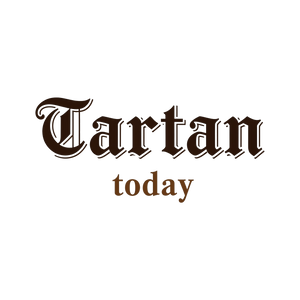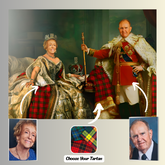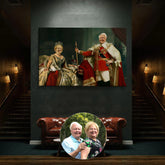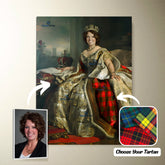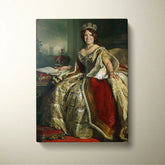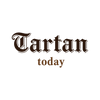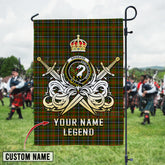-
Personalized Clan Brisbane Tartan Drummer Ornament with Custom Name – Scottish Christmas Tree Decoration TA89
Personalized Clan Brisbane Tartan Drummer Ornament with Custom Name – Scottish Christmas Tree Decoration TA89Celebrate your Scottish heritage with this unique wood & acrylic tartan ornament. Perfect as a personalized Christmas decoration or a meaningful gift for friends and relatives on special occasions such...- From $19.99 USD
$25.99 USD- From $19.99 USD
- Unit price
- per
Save $6.00 -
Personalized Clan Brisbane Tartan Bagpipe Ornament with Custom Name – Scottish Christmas Tree Decoration WI50
Personalized Clan Brisbane Tartan Bagpipe Ornament with Custom Name – Scottish Christmas Tree Decoration WI50Celebrate your Scottish heritage with this unique wood & acrylic tartan ornament. Perfect as a personalized Christmas decoration or a meaningful gift for friends and relatives on special occasions such...- From $19.99 USD
$25.99 USD- From $19.99 USD
- Unit price
- per
Save $6.00 -
Personalized Clan Brisbane Reproduction Tartan Bagpipe Ornament with Custom Name – Scottish Christmas Tree Decoration BA64
Personalized Clan Brisbane Reproduction Tartan Bagpipe Ornament with Custom Name – Scottish Christmas Tree Decoration BA64Celebrate your Scottish heritage with this unique wood & acrylic tartan ornament. Perfect as a personalized Christmas decoration or a meaningful gift for friends and relatives on special occasions...- From $19.99 USD
$25.99 USD- From $19.99 USD
- Unit price
- per
Save $6.00 -
Personalized Clan Brisbane Modern Tartan Bagpipe Ornament with Custom Name – Scottish Christmas Tree Decoration OO63
Personalized Clan Brisbane Modern Tartan Bagpipe Ornament with Custom Name – Scottish Christmas Tree Decoration OO63Celebrate your Scottish heritage with this unique wood & acrylic tartan ornament. Perfect as a personalized Christmas decoration or a meaningful gift for friends and relatives on special occasions...- From $19.99 USD
$25.99 USD- From $19.99 USD
- Unit price
- per
Save $6.00 -
Personalized Clan Brisbane Ancient Tartan Bagpipe Ornament with Custom Name – Scottish Christmas Tree Decoration PB28
Personalized Clan Brisbane Ancient Tartan Bagpipe Ornament with Custom Name – Scottish Christmas Tree Decoration PB28Celebrate your Scottish heritage with this unique wood & acrylic tartan ornament. Perfect as a personalized Christmas decoration or a meaningful gift for friends and relatives on special occasions...- From $19.99 USD
$25.99 USD- From $19.99 USD
- Unit price
- per
Save $6.00 -
Personalized Clan Brisbane Tartan Bagpipe Ornament with Custom Name – Scottish Christmas Tree Decoration XI70
Personalized Clan Brisbane Tartan Bagpipe Ornament with Custom Name – Scottish Christmas Tree Decoration XI70Celebrate your Scottish heritage with this unique wood & acrylic tartan ornament. Perfect as a personalized Christmas decoration or a meaningful gift for friends and relatives on special occasions such...- From $19.99 USD
$25.99 USD- From $19.99 USD
- Unit price
- per
Save $6.00 -
Personalized Clan Brisbane Weathered Clan Crest Tartan Santa Ornament – Custom Acrylic Christmas Decoration VQ10 - Brisbane
Personalized Clan Brisbane Weathered Clan Badge Tartan Ornament – Custom Acrylic Christmas Decoration VQ10Celebrate your Scottish heritage with this unique wood & acrylic tartan ornament. Perfect as a personalized Christmas decoration or a meaningful gift for friends and relatives on special occasions such as...- From $19.99 USD
- From $19.99 USD
- Unit price
- per
-
Brisbane
-
Personalized Clan Brisbane Modern Clan Crest Tartan Santa Ornament – Custom Acrylic Christmas Decoration DX95 - Brisbane
Personalized Clan Brisbane Modern Clan Badge Tartan Ornament – Custom Acrylic Christmas Decoration DX95Celebrate your Scottish heritage with this unique wood & acrylic tartan ornament. Perfect as a personalized Christmas decoration or a meaningful gift for friends and relatives on special occasions such as...- From $19.99 USD
- From $19.99 USD
- Unit price
- per
-
Brisbane
-
Personalized Clan Brisbane Ancient Clan Crest Tartan Santa Ornament – Custom Acrylic Christmas Decoration JP16 - Brisbane
Personalized Clan Brisbane Ancient Clan Badge Tartan Ornament – Custom Acrylic Christmas Decoration JP16Celebrate your Scottish heritage with this unique wood & acrylic tartan ornament. Perfect as a personalized Christmas decoration or a meaningful gift for friends and relatives on special occasions such as...- From $19.99 USD
- From $19.99 USD
- Unit price
- per
-
Brisbane
-
Custom Name Clan Brisbane Tartan Garden Flag with Clan Crest and the Golden Sword of Courageous Legacy HS48 - Brisbane
Custom Name Clan Brisbane Tartan Garden Flag with Clan Crest and the Golden Sword of Courageous Legacy HS48 Immerse your space in the rich heritage of Scotland with our Tartan Garden Flags, exclusively from Tartan Today. Featuring vibrant tartan and Scottish heritage designs, these garden...- From $34.45 USD
- From $34.45 USD
- Unit price
- per
-
Brisbane
-
Clan Brisbane Tartan Scotland Map Canvas “Tartan Runs Through My Veins” Wall Art YX67
Clan Brisbane Tartan Scotland Map Canvas “Tartan Runs Through My Veins” Wall Art YX67Celebrate your Scottish heritage with this striking canvas print featuring the map of Scotland filled with Brisbane tartan, paired with the bold phrase: “Tartan Runs Through My Veins.” Whether you're honoring...- From $35.05 USD
- From $35.05 USD
- Unit price
- per
-
Personalized Clan Brisbane Tartan Shirt with Scotland Coat of Arms & Custom Name QJ99 - Brisbane
Brisbane Tartan Shirt with Scotland Coat of Arms & Custom Name QJ99Celebrate your Scottish heritage with this Brisbane Tartan Shirt with Scotland Coat of Arms & Custom Name QJ99, featuring a bold Scotland Coat of Arms and your custom name on the back. Made...- From $39.54 USD
- From $39.54 USD
- Unit price
- per
-
Brisbane
-
Clan Brisbane Tartan Custom Face Hawaiian Shirt – Unisex Gift for Family Members, Summer Party NN36 - Brisbane Tartan
Clan Brisbane Tartan Custom Face Hawaiian Shirt – Unisex Gift for Family Members, Summer Party NN36?? Stand out with our custom face Hawaiian shirt featuring your chosen tartan pattern and up to 10 faces printed for free! Whether it's your own, your pet's, or...- $42.25 USD
$59.99 USD- $42.25 USD
- Unit price
- per
Save $17.74-
Brisbane Tartan
-
Clan Brisbane Tartan Flat Cap TS77 - Clan Brisbane Tartan
Clan Brisbane Tartan Flat Cap TS77Elevate Your Heritage: The Authentic Tartan Jeff Cap Step into a legacy of timeless style and comfort with our Authentic Tartan Flat Cap. Crafted for the discerning American who cherishes their Scottish roots and appreciates classic elegance, this isn’t just...- From $33.85 USD
$45.59 USD- From $33.85 USD
- Unit price
- per
Save $11.74-
Clan Brisbane Tartan
-
Clan Brisbane Tartan Crest, Badges, Heraldry, Clans, Family Scotland PNG, Digital ClipArt High Quality EA14
Clan Brisbane Tartan Crest, Badges, Heraldry, Clans, Family Scotland PNG, Digital ClipArt High Quality EA14 DIGITAL FILE ONLY* ** This listing is an INSTANT DIGITAL DOWNLOAD, not a physical item. An instant download is a digital file you can download and use immediately **...- $3.49 USD
$5.99 USD- $3.49 USD
- Unit price
- per
Save $2.50 -
Clan Brisbane Modern Tartan Polo Shirt Viking Wolf KV45 - Brisbane Modern Tartan
Clan Brisbane Modern Tartan Polo Shirt Viking Wolf KV45 Description: Crafted in 100% polyester with your own design which combines comfort and vogue. This shirt has some'great features, it has 3 buttons, elastic collar and cuffs. 12.35 Oz. Made from polyester fabric. 3 buttons,...- $38.25 USD
- $38.25 USD
- Unit price
- per
-
Brisbane Modern Tartan
-
Clan Brisbane Modern Tartan Polo Shirt Half of Me - Cross Style HK35 - Brisbane Modern Tartan
Clan Brisbane Modern Tartan Polo Shirt Half of Me - Cross Style HK35 Description: Crafted in 100% polyester with your own design which combines comfort and vogue. This shirt has some'great features, it has 3 buttons, elastic collar and cuffs. 12.35 Oz. Made from...- $38.25 USD
- $38.25 USD
- Unit price
- per
-
Brisbane Modern Tartan
-
Clan Brisbane Modern Tartan Polo Shirt - Royal Coat Of Arms Style PG48 - Brisbane Modern Tartan
Clan Brisbane Modern Tartan Polo Shirt - Royal Coat Of Arms Style PG48 Description: Crafted in 100% polyester with your own design which combines comfort and vogue. This shirt has some'great features, it has 3 buttons, elastic collar and cuffs. 12.35 Oz. Made from...- $38.25 USD
- $38.25 USD
- Unit price
- per
-
Brisbane Modern Tartan
-
Clan Brisbane Modern Tartan Polo Shirt - Lion Rampant And Celtic Thistle Style PO25 - Brisbane Modern Tartan
Clan Brisbane Modern Tartan Polo Shirt - Lion Rampant And Celtic Thistle Style PO25 Description: Crafted in 100% polyester with your own design which combines comfort and vogue. This shirt has some'great features, it has 3 buttons, elastic collar and cuffs. 12.35 Oz. Made...- $38.25 USD
- $38.25 USD
- Unit price
- per
-
Brisbane Modern Tartan
-
Clan Brisbane Modern Tartan Polo Shirt - Believe In Me Style HY11 - Brisbane Modern Tartan
Clan Brisbane Modern Tartan Polo Shirt - Believe In Me Style HY11 Description: Crafted in 100% polyester with your own design which combines comfort and vogue. This shirt has some'great features, it has 3 buttons, elastic collar and cuffs. 12.35 Oz. Made from polyester...- $38.25 USD
- $38.25 USD
- Unit price
- per
-
Brisbane Modern Tartan
Ex: Your Tartan + Product
Popular Products
Turn Me Royal Personalized Portrait from Your Photo, Custom Tartan. Custom Canvas Wall Art as Gift for Men
- From $32.45 USD
- From $32.45 USD
- Unit price
- / per
Royalty Couple Personalized Portrait from Your Photo, Custom Tartan. Custom Canvas Wall Art
- From $47.45 USD
- From $47.45 USD
- Unit price
- / per
The Queen Personalized Portrait from Your Photo, Custom Tartan. Custom Canvas Wall Art as Gift for Women
- From $32.45 USD
- From $32.45 USD
- Unit price
- / per
Which Clan Are You From?
List Of Tartan
-
Clan A
- Abercrombie Tartan
- Aberdeen Tartan
- Abernethy Tartan
- Adair Tartan
- Adam Tartan
- Ayrshire Tartan
- Agnew Tartan
- Aikenhead Tartan
- Ainslie Tartan
- Aiton Tartan
- Allan Tartan
- Alexander Tartan
- Allardice Tartan
- Allison Tartan
- Anderson Tartan
- Angus Tartan
- Anstruther Tartan
- Arbuthnot Tartan
- Armstrong Tartan
- Arnott Tartan
- Auchinleck Tartan
- Ayrshire Tartan
-
Clan B
- Baillie Tartan
- Bain Tartan
- Baird Tartan
- Balfour Tartan
- Bannatyne Tartan
- Bannerman Tartan
- Barclay Tartan
- Baxter Tartan
- Beaton Tartan
- Bell Tartan
- Belshes Tartan
- Bethune Tartan
- Beveridge Tartan
- Binning Tartan
- Bisset Tartan
- Blackadder Tartan
- Blackstock Tartan
- Black Watch Tartan
- Blair Tartan
- Blane Tartan
- Blyth Tartan
- Borthwick Tartan
- Boswell Tartan
- Bowie Tartan
- Boyd Tartan
- Boyle Tartan
- Brisbane Tartan
- Brodie Tartan
- Brown/ Broun Tartan
- Bruce Tartan
- Buccleuch Tartan
- Buchan Tartan
- Buchanan Tartan
- Burnett Tartan
- Burns Tartan
- Butter Tartan
- Byres Tartan
-
Clan C
- Cairns Tartan
- Calder Tartan
- Callander Tartan
- Cameron Tartan
- Campbell Tartan
- Campbell of Breadalbane Tartan
- Campbell of Cawdor Tartan
- Carmichael Tartan
- Carnegie Tartan
- Carruthers Tartan
- Cathcart Tartan
- Chalmers Tartan
- Charteris Tartan
- Chattan Tartan
- Cheyne Tartan
- Chisholm Tartan
- Christie Tartan
- Clark Tartan
- Clelland Tartan
- Clephan Tartan
- Clergy Tartan
- Cochrane Tartan
- Cockburn Tartan
- Colquhoun Tartan
- Colville Tartan
- Cooper Tartan
- Couper Tartan
- Craig Tartan
- Cranstoun Tartan
- Crawford Tartan
- Crichton Tartan
- Crief District Tartan
- Crosbie Tartan
- Cumming Tartan
- Cunningham Tartan
- Currie Tartan
- Clan D
- Clan E
- Clan F
- Clan G
- Clan H
- Clan I
- Clan J
- Clan K
- Clan L
-
Clan M
- Maitland Tartan
- Malcolm Tartan
- Mar Tartan
- Marjoribanks Tartan
- Maxtone Tartan
- Matheson Tartan
- Maule Tartan
- Maxwell Tartan
- Meldrum Tartan
- Melville Tartan
- Menzies Tartan
- Mercer Tartan
- Middleton Tartan
- Moffat Tartan
- Moncrieffe Tartan
- Montgomery Tartan
- Monypenny Tartan
- Moncreiffe Tartan
- Monteith Tartan
- Morrison Tartan
- Mouat Tartan
- Moubray Tartan
- Mow Tartan
- Muir_More Tartan
- Muirhead Tartan
- Munro Tartan
- Murray Tartan
- Murray of Atholl Tartan
-
Clan Mc/Mac
- MacAlister Tartan
- MacArthur Tartan
- MacAlpine Tartan
- MacAulay Tartan
- MacBain Tartan
- MacBean Tartan
- MacBeth Tartan
- MacCallum Tartan
- MacCraig Tartan
- MacColl Tartan
- MacCorquodale Tartan
- MacDiarmid Tartan
- MacDonald Tartan
- MacDonald of Clanranald Tartan
- MacDonald of Sleat Tartan
- MacDonnell of Glengarry Tartan
- MacDonnell of Keppoch Tartan
- MacDougall Tartan
- MacDowall Tartan
- MacDuff Tartan
- MacEwen_MacEwan Tartan
- MacEdward Tartan
- MacFarlane Tartan
- MacGill Tartan
- MacGillivray Tartan
- MacGregor Tartan
- MacGowan (McGowan) Tartan
- MacHardy Tartan
- MacIan Tartan
- MacInnes Tartan
- MacIntyre Tartan
- MacKay Tartan
- MacKillop Tartan
- MacKellar Tartan
- Mackinlay Tartan
- MacKenzie Tartan
- Mackie Tartan
- MacKinnon Tartan
- MacKintosh / MacIntosh Tartan
- MacLeod Tartan
- MacMillan Tartan
- MacNab Tartan
- MacNaughton Tartan
- MacNeil / MacNeill Tartan
- MacNeil of Colonsay Tartan
- MacNicol Tartan
- MacPhail Tartan
- MacPhee_MacFie Tartan
- MacPherson Tartan
- MacQuarrie Tartan
- MacQueen Tartan
- MacRae Tartan
- MacRow Tartan
- MacSporran Tartan
- MacTaggart Tartan
- MacTavish Tartan
- MacThomas Tartan
- McCorquodale Tartan
- McCulloch Tartan
- McFadzen Tartan
- McGeachie Tartan
- McIver Tartan
- McKerrell Tartan
- Clan N
- Clan O
- Clan P
- Clan R
-
Clan S
- Sandilands Tartan
- Scott Tartan
- Scrymgeour Tartan
- Selkirk Tartan
- Sempill Tartan
- Seton Tartan
- Shaw Tartan
- Shepherd Tartan
- Sinclair Tartan
- Skene Tartan
- Skirving Tartan
- Smith Tartan
- Somerville Tartan
- Spalding Tartan
- Spens Tartan
- Spottiswood Tartan
- Stevenson Tartan
- Stewart Tartan
- Stewart of Appin Tartan
- Stirling Tartan
- Strachan Tartan
- Straiton Tartan
- Strange Tartan
- Strathclyde District Tartan
- Stuart of Bute Tartan
- Sutherland Tartan
- Swinton Tartan
- Clan T
- Clan U W Y
- Request Your Clan
Clan Brisbane (Brisbane Tartan)
1. About Clan Brisbane (Brisbane Tartan)
2. Clan Brisbane History (Brisbane Tartan)
The word "brise bane," which means "break bone" or "bonebreaker," is Anglo-French in origin.
William Brisbone, who was most likely from England and was listed among the archers dispatched from Berwick to Roxburgh in 1298, is the first person by that name to be found in Scotland.
Thomas Brisbane possessed a charter from Robert I for Litill Rothy in Aberdeenshire.
Soon about 1334, Alanus dictus Brisbane filius quondam Willelmi Brisbane received grants from Donald, Earl of Lennox for the lands Mucherach in the earldom of Levenax and Holmedalmartyne.
In 1415, Thomas Brysbane, dominus de Latheris, was there when William de Haya de Erole received the charter for the barony of Cowie, and in 1417, he was there when Tarwas and Udny's holdings were inspected.
In 1498, James Brisbane was the proprietor of the Reise and Akirgyll lands in Caithness.
In the early fourteen hundreds, the Brisbanes of Bishoptoun purchased the lands of Killincraig and Goga in the parish of Largs. By virtue of a Crown charter issued in 1695, the land was elevated into the status of a barony, and the family became known as the Brisbanes of Brisbane.
The Australian city of Brisbane is named in honor of Thomas Brisbane, 1st Baronet (1773–1860), who had a notable military career.
According to George Robertson's book, "A Genealogical Account of the Principal Families in Ayrshire," "this family, confessedly chief of the name, appears to have owned Bishopton in Renfrewshire, as well as lands in the counties of Stirling and Ayr, long before the date of any charters they have preserved."
Around 1332, the clan purchased the Bishopton grounds, on which Bishopton House was later constructed. The Brisbane family owned the land for more than 400 years before it was transferred to the Walkinshaws around 1671.
3. Clan Brisbane Tartans
Brisbane Family Tartan (Not a synthetic fiber)
The Paisley District tartan, which represents the area where the name is typically found, or the Gordon tartan—of which Clan Brisbane is a sept—can be worn by those related with the name.
Paisley District
Gordon Ancient
Gordon Modern
4,. Clan Brisbane Crest & Coats of Arms
4.1 Clan Brisbane Crest
Worn by all of the name and ancestry
4.2 Clan Brisbane Coat of Arms
Note on Coats of Arms: A coat of arms is given to an individual under Scottish heraldic law (with the exception of civic or corporate arms). A 'family coat of arms' does not exist.
With the exclusions listed above, the weapons depicted below are personal weapons. The only person authorized to use these weapons is the grantee.
5. Clan Brisbane Places & People
5.1 Clan Brisbane Places
Brisbane House
5.2 Clan Brisbane People
Major-General Sir Thomas Makdougall Brisbane, 1st Baronet (1773 – 1860)
Ayrshire's Noddsdale, close to Largs, is where Brisbane was born. At the University of Edinburgh, he majored in mathematics and astronomy. Brisbane.
After receiving his degree, he served in the British Army under the Duke of Wellington in Flanders, the West Indies, Spain, and North America. He advanced to the position of Major General, participated in the Peninsular War, and was given the Army Gold Cross.
He was chosen to be the governor of New South Wales in 1821, and he served in that capacity for five years as the colony rapidly grew.
The oldest academic institution in the Southern Hemisphere, the Royal Society of New South Wales, which he served as its first president, was once known as the Philosophical Society of Australasia.
Moreton Bay received a designation as a prison settlement in 1824. This was given the name Brisbane and recognized as a town in 1834 before becoming a free settlement five years later. Brisbane, a city, was founded from the settlement.
Brisbane spent his life working on his estate before returning to Scotland in 1826. In 1832, he succeeded Sir Walter Scott as the head of the Royal Society of Edinburgh, and in 1836, he was made a baronet.
Brisbane passed away in Largs and is interred in the Brisbane Aisle Vault, which is in the tiny kirkyard next to Skelmorlie Aisle, Largs Old Kirk.
- Choosing a selection results in a full page refresh.
